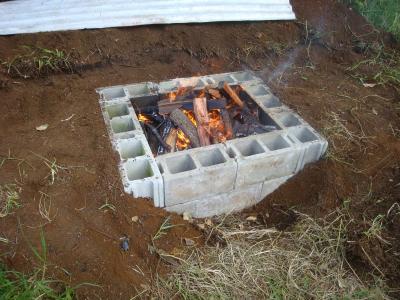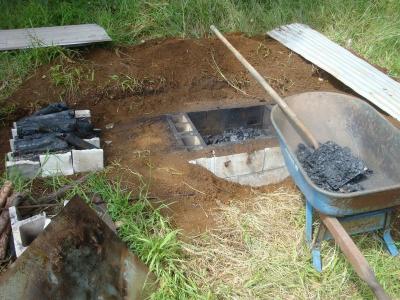Biochar Retort vs Pit Trials, Ahualoa, Hawaii
- Log in to post comments
Ben Discoe, July, 2010
I have now done tests with a pit, and contrasted with the retort.
For information on the retort see: http://terrapreta.bioenergylists.org/content/small-kilnretort-my-farm-ahualoa-hawaii and http://tech.groups.yahoo.com/group/biochar/message/11011
Since the retort had issues, i looked for a way to get larger capacity and fewer parts to wear out. The idea: a pit lined with concrete blocks, which can be covered with a piece of sheet metal and soil.
http://picasaweb.google.com/lh/photo/EvSIQ36xHXUHXEOCR25lMA?feat=directlink
http://picasaweb.google.com/lh/photo/81X5Ru49kaupg3ZTI10m7g?feat=directlink
http://picasaweb.google.com/lh/photo/pJk62bETLpcn1fkRt17Igg?feat=directlink
The blocks make a hard flat surface that's easy to unload, and cleanly separate the char from the soil. It works surprisingly well. As with jaywfitz's method (http://sensiblesimplicity.lefora.com/2010/04/28/biocharterra-pretta/#post13), wood is added gradually, the pile builds up and the bottom is oxygen-starved so it pyrolyses. When the pit is full, it is covered and left for a day to cool down. The next day, there is some incompletely-charred wood at the top of the pile, but this is not a problem, it's simply put aside and added to the next burn.
No water is needed to control or put out the fire.
Because temperature never gets that high at the walls, the blocks don't crack.
It's less picky about the size and shape of the wood, because an open fire is simpler than packing a retort.
It's difficult to judge how much ash is present (and hence the level of efficiency due to consumed feedstock), but it doesn't look like much ash at all. In fact it's possibly, even likely, more efficient than the retort, in which ~50% of the wood (which is outside the retort) is burned to ash.
A small pit of 16 x 24 x 32" (7.11 ft3, 53.2 gallons) yields around 16-17 gallons (loose chunks and fines) of char. It takes 33 CMU blocks to build. It took 40 minutes to load, fire and cover. The next day, it took 55 minutes to uncover, unload, and sift/sort the result using screen frames into 1/4"-, 1/4-1/2", and 1/2"+. These times, especially the unload/sorting, could definitely be improved by streamlining the process.
It should be possible to scale up significantly - e.g. a 24 x 32 x 48" pit (48 CMU blocks) should produce ~50 gallons per burn. I'll be trying that next.
-Ben
http://ahualoa.net/ag/notes_biochar.html
Asics footwear | Nike Little Posite Pro USA CZ2520-600 Release Date - SBD



